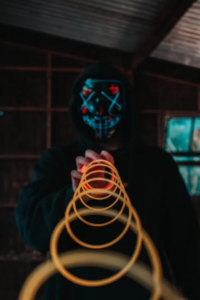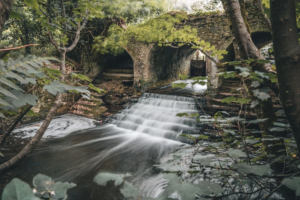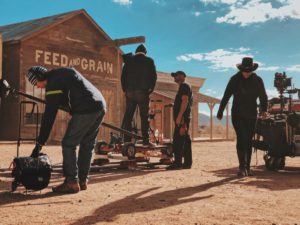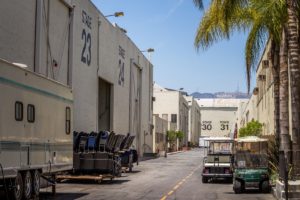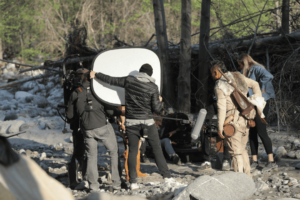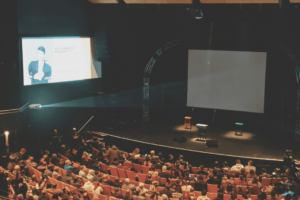To intercut is to juxtapose one shot or scene with another contrasting one. For example, a car chase scene suits an intercut. An intercut like this might show footage inside the cars of the fleeing criminal and the police in pursuit. When a film sequence jumps backward and forward between the two scenes, we call it an intercut.
An intercut typically juxtaposes scenes in different locations. However, filmmakers can also intercut one shot type with another contrasting shot type. For example, they might move from a close-up to a wide shot. While this film sequence uses the technique of intercutting, it is not called an intercut on the film’s script.
Filmmakers have used intercuts throughout cinematic history. D.W. Griffiths pioneered the technique as early as 1909. His intercuts enhanced continuity in his films. One of his most notable examples is the 1916 film “Intolerance.” In this ambitious movie, Griffiths intercuts four parallel storylines occurring centuries apart.
Reasons to Intercut
Filmmakers use intercuts for several reasons. This technique can:
- Tell a more complex story with multiple plot lines
- Make a story more engaging by skipping over unnecessary details
- Emphasize the link between different scenes
- Show contrast between different scenes
- Add drama or tension
- Summarize some action or narrative development
- Make a script shorter and more readable by eliminating multiple scene headings/sluglines
Intercuts usually show different perspectives or propel action in the following scene types:
- Phone calls
- Digital conversations through text message or online instant messaging
- Scenes where one character watches another from a distance, such as scenes involving a stalker
- Alternate reality scenes
- Preparation scenes
An intercut isn’t always the best option, though. If an intercut shows any more than two locations, it can become confusing. In these instances, screenwriters should consider whether other film techniques would make their narrative clearer.
An intercut can also be confusing if the scenes juxtaposed together are very long. Following the two different sides of a simple telephone call using an intercut is easy. Two or more juxtaposed scenes that are lengthier, and thus more elaborate, may be too difficult for viewers to follow at the same time. Another film technique could also make these scenes clearer.
How to Show an Intercut in Your Script
Sometimes directors add intercuts to their films during post-production. However, in many cases, screenwriters add intercuts to their scripts. Including an intercut on a script lets the director and editor know about the screenwriter’s vision. They can then consider that vision when they’re shooting the movie.
An intercut also lets a screenwriter write a single scene heading for each shooting location, rather than multiple sluglines. That’s because an intercut sequence is essentially a single scene shot in multiple locations. Follow these steps to add an intercut to your own script:
- Write the slugline for each location. Make sure to describe whether it is an interior or exterior shot and day or night.
- Show the scenes intercut together by writing the word “INTERCUT,” all in capital letters, at the top left of the intercut section. You could also write “INTERCUT CHARACTER A/CHARACTER B,” substituting the names of the main characters in your intercut scene, or “INTERCUT CHARACTER AND LOCATION A/CHARACTER AND LOCATION B,” substituting your characters and their locations.
- Finally, write the action and dialogue for the intercut sequence as if it was a standard scene.
What Is the Difference Between an Intercut and a Montage?
Intercuts and montages both juxtapose footage in different locations. While a montage can technically be classed as an intercut, its shots are much shorter. A montage also doesn’t usually return to the same scenes as an intercut does.
What Is the Difference Between an Intercut and a Flashback?
Intercuts and flashbacks also juxtapose footage from different locations. While the scene in a flashback is intercut with a scene from the film’s current timeframe, it is not classified as an intercut. That’s because the scenes in an intercut occur at the same time as one another.
Could I Use a Split-Scene Instead of an Intercut?
A split-scene can certainly show two scenes occurring at the same time, just as an intercut does. This film device was common in movies made in the past, however. Intercuts are much more modern. Experts suggest that unless you have a specific reason for using a split-screen, an intercut is the best choice for modern films.
Intercut Examples
Examining the way filmmakers intercut scenes in their own films can help you understand this technique and its impact better. These are just a few of the films that use intercut sequences well.
“A Fistful of Dollars” (1964): Good and Evil Face Off
An intercut sequence brings the thrilling gunfight in Sergio Leone’s iconic western, “A Fistful of Dollars,” to life. Leone juxtaposes scenes of Clint Eastwood’s Man With No Name facing off with his mortal enemy, Ramón Rojo. While these two men are in the same location, staring one another down before taking aim, the intercut adds a different kind of drama than using a two shot would.
Leone’s choice lets us see the faces of each man clearly. This ensures we can easily read their emotions as they walk towards each other. It sets off a classic battle of good and evil. The intercut separates these two opposing forces until they come together for the ultimate standoff. The presentation emphasizes the film’s moral, forcing viewers to question the violence of the Wild West.
“The Godfather” (1972): Baptism Scene
Intercutting adds dramatic effect in Francis Ford’s Coppola’s 1972 masterpiece, “The Godfather.” The scene shows Michael Corleone rejecting Satan in the church before his godson gets baptized. However, the scenes it’s cut with reveal a darker tone. The church scene is intercut with shots of the murders Corleone has already ordered occurring as the service takes place.

Image via No Film School
Juxtaposing the church scene with the wave of destruction the mob boss unleashed reveals he is not just here for family. Participating in the church service also gives Corleone an alibi.
“The Deer Hunter” (1978): Wedding and Hunting
An intercut is one of the first key scenes in Michael Cimino’s war drama, “The Deer Hunter.” Cimino juxtaposes footage of a vibrant Russian Orthodox wedding with footage of hunters tracking deer in the woods. Weddings, especially in the Russian Orthodox faith, are elaborate, ritualistic affairs. Taking hunting trips with friends is another activity steeped in ritual. Ritual goes on to be a central theme in this film, all set up by this clever intercut.
“Star Wars: Episode III – Revenge of the Sith” (2005): Two Key Concurrent Events Change the Fate of the Galaxy
George Lucas intercut scenes showing two pivotal moments in the galaxy’s history: Darth Vader’s acceptance of the Dark Side and the birth of his two heroic children, Luke and Leia. The intercut shows that while these events occur in different locations, they are closely linked. Lucas wrote the scenes separately but linked them with intercutting during the editing process.
Intercut is an exciting tool that can make movies more effective and engaging. To learn more about developing and applying techniques like intercut, join the Cinema Product Diploma program at Nashville Film Institute today.



